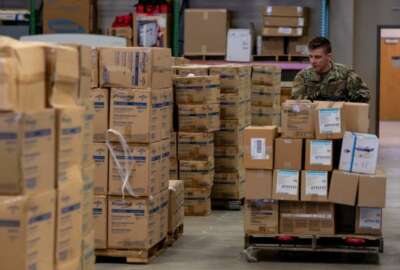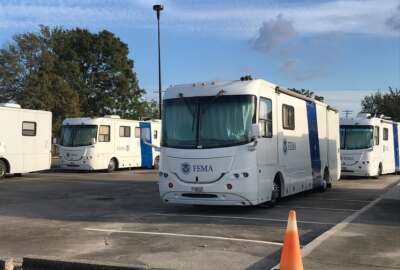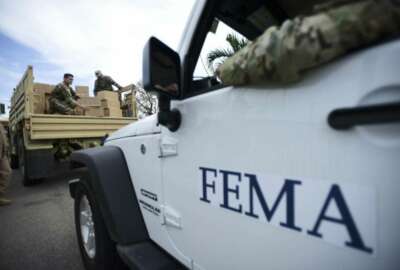
Nonprofit recommends amending Stafford Act to include FEMA in pandemic, cyber incident response
In response to the pandemic, a non-profit of business executives devoted to national security issues created a commission to examine how to improve federal...
A nonprofit of business executives wants Congress to broaden the definition of what constitutes a disaster to include pandemics and cyber incidents.
A commission stood up by Business Executives for National Security (BENS) in response to the COVID-19 pandemic recommended that Congress do this by amending the Stafford Disaster Relief and Emergency Assistance Act. That would allow FEMA to respond to these incidents sooner, providing support and coordination for agencies leading the response.
Gen. Joseph Votel, retired CENTCOM commander and president and CEO of Business Executives for National Security, told the Senate Homeland Security and Governmental Affairs Subcommittee on Emerging Threats and Spending Oversight during a March 24 hearing that there was a fundamental disconnect early on during the current pandemic. The initial reaction focused on the medical nature of the event, and the Department of Health and Human Services was put in charge of response, while FEMA was only brought in later.
“When everything hit the fan, my appropriations guys said there’s no way FEMA doesn’t take the lead, because they have to dispense a lot of money very quickly. And HHS does not have the infrastructure to do that,” said Sen. Bill Cassidy (R-La.). “And then I was speaking to a doctor involved with disposition of ventilators — HHS had that expertise. But FEMA took it over, because, as I gather, because they were now writing the checks. They may have come late to the game, but they were dominating the game. And so they are now making decisions, which frankly, they didn’t have the training to do.”
If FEMA had been included from the beginning explicitly in a role providing infrastructure and coordination in support of HHS, this disconnect could have been avoided, according to the commission’s report.
The commission, which was co-chaired by former Homeland Security Secretary Jeh Johnson, had initially been looking to determine a new model for federal emergency response altogether, Votel said. But after interviewing 165 stakeholders across government and industry, they determined instead that the current model actually works; it just has some kinks to work out.
The three main areas the commission highlighted that need work are:
- facilitating communications and coordination,
- delivering supplies and volunteer resources, and
- leveraging emerging technologies.
Other than amending the Stafford Act, the commission’s 11 recommendations also included – but were not limited to – redesigning FEMA’s National Response Coordination Center to help coordinate with first responders, industry and the National Strategic Stockpile; developing a national disaster app to share information about ongoing disaster responses; and using AI and predictive analytics to identify potential future threats.
“Through the National Response Coordination Center, FEMA can have some ability in making sure that we have on-hand the appropriate resources to deal with any of these particular emergencies,” Votel said. “An important role that FEMA plays in this through things like the NRCC is the ability to have well-established relationships with industry and with other civil organizations out there who are providing the resources for this. So I think it is absolutely critical that they play in this particular area.”
HHS currently oversees the National Strategic Stockpile, but Votel said FEMA could contribute by helping to manage and distribute those resources. And its contacts among industry could address potential supply chain concerns. One suggestion was that FEMA could help avoid production bottlenecks caused by the “just-in-time” model currently used to surge supplies and resources during a crisis by arranging blanket purchase orders before crises even occur, and paying vendors nominal fees to hold capacity and capabilities until they’re needed.
And there are other ways the NRCC could potentially help coordinate with non-traditional responders. Kristi Rogers, managing partner at Principal to Principal LLC, said at the hearing that during the pandemic, there were businesses that wanted to help with responding to the crisis, but there was no clear path for them to offer assistance. FEMA’s NRCC could potentially provide such a centralized contact.
Rogers also suggested that the NRCC needs the capability to map supply chains in order to reveal vulnerabilities, such as when critical resources needed during a crisis are only available to purchase from non-allied countries. But before that can even happen, she said, there needs to be agreement on what resources are even deemed “critical,” which is a determination FEMA is equipped to help with.
Copyright © 2025 Federal News Network. All rights reserved. This website is not intended for users located within the European Economic Area.
Daisy Thornton is Federal News Network’s digital managing editor. In addition to her editing responsibilities, she covers federal management, workforce and technology issues. She is also the commentary editor; email her your letters to the editor and pitches for contributed bylines.
Follow @dthorntonWFED





